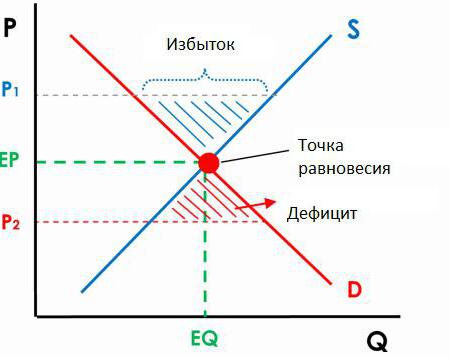If you study at a business school, then you need to understand all economic terms. The theory is remembered much faster if it is considered on concrete examples. In this article we will consider the types of competition in the economy with examples. And let's start with how they differ and what their main characteristics are. 
Perfect competition
At first glance, perfect competition is an ideal market situation. All manufacturers produce exactly the same products, which have certain unbreakable standards. In this market, there are no barriers to entry, no one regulates the pricing process. You can gain customer loyalty by various marketing methods, but without changing the product itself.
It is very difficult to find examples of perfect competition in the economy. In reality, this situation practically does not exist. This can be attributed only to farming, when each of the owners grows the same potatoes, cabbage and cucumbers. 
Monopolistic competition
There are quite a few manufacturers on the monopoly market; they produce similar or related products. There is little control over pricing on the market; you can enter the fight for the right to exist without much effort. Monopolistic competition is almost all small firms and companies that produce products or offer services.
It is easy to give concrete examples of competition in the economy. These are completely markets of light, food industry. These are travel agencies, law firms, hairdressers and much more. Think about what is in your city in abundance, and you will immediately understand what is at stake.
The methods of competition in the monopolistic market are enormous. Here is a very wide range of possibilities with virtually no limits. Advertising, a game with a price or quality, various slogans, trademarks and signs, etc. 
Oligopoly
There are few manufacturers on the oligopoly market. Usually their number does not exceed ten. As a rule, all products are homogeneous or differentiated. The state exercises partial control over pricing, more often it simply controls that companies are not impudent and keep their value at an acceptable level. Entering the market is very difficult. All oligopolists are large companies that are hard to grow to. They control the whole situation and do not like when someone tries to bother them.
Therefore, competition here has its own special character. There are two options. Either companies try to get out of each other by all means, or simply behave as partners and agree among themselves.
The market of mobile operators, the chemical and aviation industries are good examples of competition in the economy. The conditions for the oligopolistic market are the same - there should be no more than 7-10 companies. 
Pure monopoly
A pure monopoly market is a situation where there is only one producer. He fully controls the production and marketing of products and actually sets his own rules. In this case, tight control by the state is necessary. The advantages of competition in the economy are that, thanks to the presence of several companies, they are improving, trying to attract the attention of the buyer.
There is no such thing in a pure monopoly. The company can produce the same thing for years without any modernization, which will lead to stagnation and lower quality. Examples of competition in the economy regarding pure monopoly can be found in the field of natural monopolies.
These are companies engaged in the provision of services related to the use of natural resources: water utilities, gas holdings, thermal power plants and others.
Competition features
Economists identify six main areas through which competition helps to develop market conditions. Consider the functions of competition in a market economy, examples and results.
Regulatory function
At the heart of any market economy is the balance of supply and demand. The company will produce exactly as many products as the consumer needs. The process of forming the required quantity is the topic of a separate article, so we will not talk about it now.
The regulation is that, thanks to research, analysis of demand and sales, the company sets the volume of production that is necessary to meet the needs of the market. Such examples of competition in the economy are usually depicted using a simple graph, presented below.
The horizontal line displays the quantity, the vertical - demand. Suppose an enterprise produces furniture. At the equilibrium point, the number of sofas, cabinets and tables is equal to the requirements of the customers. For example, a company produces 10 sofas, 5 cabinets, and 12 tables per month. If the company begins to produce less furniture, and demand remains at the same level, there will be a deficit, marked by a red dotted line.
And the opposite situation. Surplus furniture will not be sold, they will remain in warehouses, and this will lead to higher costs. This position is marked with a blue dotted line and means an excess. This displays the regulatory function of competition.
Allocation function
Allocation translated from English means placement. In fact, this means that all factors and objects of production should be located most favorably with respect to the source of production and the consumer.
Examples of competition in the economy are fairly easy to find. Thus, hydropower plants are located at the source of water resources, and the generated electricity is sent to those regions that are located closest. A similar situation can be observed at all resource-mining enterprises. As a rule, processing and recycling plants are in close proximity.
Innovative feature
An innovative function in the modern world plays one of the most important roles. Technologies are changing so fast that sometimes introducing them brings huge costs. But thanks to innovation, quality improves, labor productivity increases, and working conditions improve. Even if the company is in doubt whether to introduce a new product or not, we suggest considering an example of the industrial giant in America - Nucor Steel.
In 1986, the company's revenues were somewhere in the middle. In fact, this steel casting company was no different from its competitors. But then the president of the company managed to get documents on the development of a new technology. She was "damp", has not yet passed verification and control, but promised tremendous results. Its implementation also required very large resources, which the company did not have at that time. But Kenes Iverson, president of the firm, took a chance. And I was not mistaken. Within a few years, Nucor Steel managed to absorb several small firms and break into the leadership of the steel industry for decades to come.
Distribution function
It is also called motivating. The company that wants to stay in the market and win the consumer will do everything possible to achieve this. Anyone who has their own business knows that at one moment you can easily get burned out, even if everything, it would seem, is already working out. 48% of small firms leave the market in the first year after their appearance, another 60% complete their activities within three years. This is especially evident in retail outlets.
Lack of necessary knowledge and poor market analysis lead to such deplorable consequences.On the other hand, the distribution function can prove itself in the process of spin-off of small companies from large corporations. 
Supervisory function
If you look at the characteristics of each type of market, you can see that each of them has regulatory bodies. At monopolies and oligopolies This is the Antimonopoly Committee. But in pure and monopolistic competition there are no external regulatory bodies, because they are not needed.
Since the consumer himself chooses whom to buy from, competitors cannot set a price significantly higher than the opponent’s price or lower the quality. This will lead to loss of customers, which means potential bankruptcy. Skilful maneuvering and constant work on mistakes are the key success factors where there are many similar firms.
Risky Steps - How Ryanair Outperformed Airline Leaders
Let us give examples of competition in the economy, which have proved that sometimes the risk can be justified and will bring unthinkable results. As mentioned earlier, it is extremely difficult to enter the oligopolistic market. Almost impossible. A local airline company in America has challenged giants such as British Airways and Aer Lingus. No one believed in the success of a small player. But, having mobilized all the resources, the company began selling tickets at record low prices.
This has provided long-term benefits. Since most passengers moved from trains to aircraft, they became regular customers of Ryanair and even after increasing ticket prices continued to use the services of a carrier. 
How staff motivation strategy gives you competitive advantages
The examples of competition in a market economy do not end there. In order to gain any competitive advantage, companies go to all sorts of tricks. One of the amazing strategies demonstrated by the American company Lincoln Electric Co. All its employees are guaranteed not to remain without work until the end of their lives, and the salary depends on the profits of the company. The higher this indicator, the greater the premium.
We have given examples of competition in the economy depending on type of market and the functions that it performs. In general, it can be noted that competition is always an engine of progress and a powerful impetus for the development of market conditions.






